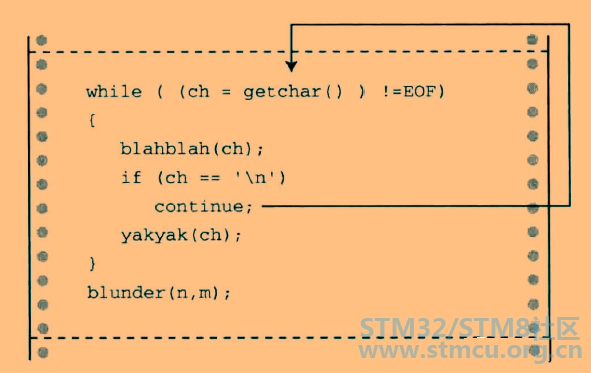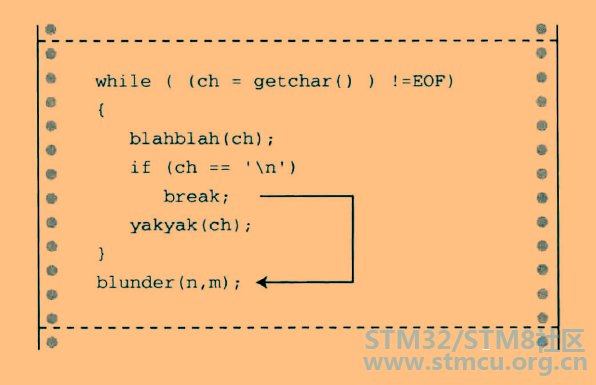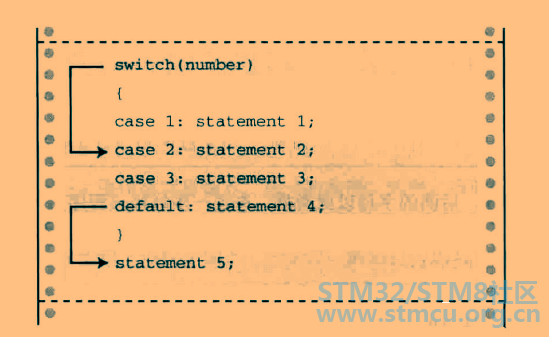
|
首先说明:continue 只能用于循环语句中,而break可用于循环和 switch 语句,两者都是辅助循环;尽管如此,如果 switch 语句在一个循环中,continue便可作为 switch 语句的一部分;这种情况下,就像在其他循环中一样,continue 让程序跳出循环的剩余部分,包括 switch 语句的其他部分。一般而言,程序进入循环后,在下一次循环测试之前会执行完循环体内部的所有语句。而continue和break语句可以根据循环体内部的测试结果来忽略一部分循环内容,甚至结束循环。 c 语言中循环语句有 3 种:while(); do while(); for;且 3 种循环都可以使用 continue 和 break 语句 对于continue语句,执行到该语句时,会跳过本次迭代的剩余部分,并开始下一轮迭代;但是若 continue 语句在嵌套循环的内部,则只会影响包含该语句(即 continue 语句)的内层循环(即内层循环的后面的语句不会被执行,而跳出内层循环后,外层循环内部的语句正常执行。); 然而对于 while() 和 do while() 循环,执行 continue 语句后的下一个行为是对循环的测试表达式求值,看代码实例: #include <stdio.h> int main() { //while() char CH; int count=0; while(count < 10){ CH = getchar(); if(CH != ' ') continue; putchar(CH); count++; } printf("Hello, World!\n"); return 0; } 对于 for 循环,执行 continue 之后的下一个行为是对更新表达式求值,然后是对循环测试表达式求值,下面的代码示例包括了嵌套循环中使用 continue 的情形: #include <stdio.h> int main() { char ch; int cunt; int i; for(cunt=0;cunt<10;cunt++){ ch = getchar(); for(i=0;i<5;i++){ if (ch != ' ') continue; putchar(ch); printf("我是内层循环的---小可爱!!!\n"); } printf("我是外层循环的---小可爱!!!\n"); printf("如果continue语句在嵌套循环内,则只会影响包含continue的内层循环,不影响外层循环!!!\n"); } printf("Hello, World!\n"); return 0; } 对于 break 语句: 程序执行到循环中的break语句时,会终止包含它的循环,并继续执行下一阶段;若break位于嵌套循环内部,它只影响包含它的当前循环。 比较 break 和 continue 对程序执行的不同之处,看下图: continue: 
continue跳出本次循环,执行下一次循环。 break: 
break跳出整个循环 下面看代码 while 示例: #include <stdio.h> int main() { //while() char CH; int count=0; while(count < 10){ CH = getchar(); if(CH != ' ') break; putchar(CH); count++; } printf("Hello, World!\n"); return 0; } for循环及嵌套循环示例:注:只会直接跳出内层循环,外层循环正常执行#include <stdio.h> int main() { char ch; int cunt; int i; for(cunt=0;cunt<10;cunt++){ ch = getchar(); for(i=0;i<5;i++){ if (ch != ' ') break; putchar(ch); printf("我是内层循环的---小可爱!!!\n"); } printf("我是外层循环的---小可爱!!!\n"); printf("如果continue语句在嵌套循环内,则只会影响包含continue的内层循环,不影响外层循环!!!\n"); } printf("Hello, World!\n"); return 0; } 要想外层循环一并终止;需要在外层在使用 break;#include <stdio.h> int main() { char ch; int cunt; int i; for(cunt=0;cunt<10;cunt++){ ch = getchar(); for(i=0;i<5;i++){ if (ch != ' ') break; putchar(ch); printf("我是内层循环的---小可爱!!!\n"); } if (ch != ' ') break; printf("我是外层循环的---小可爱!!!\n"); printf("如果continue语句在嵌套循环内,则只会影响包含continue的内层循环,不影响外层循环!!!\n"); } printf("Hello, World!\n"); return 0; } 在多重选择 switch 语句中使用 continue 和 break的示例:/* animals.c -- uses a switch statement */ #include <stdio.h> #include <ctype.h> int main(void) { char ch; printf("Give me a letter of the alphabet, and I will give "); printf("an animal name\nbeginning with that letter.\n"); printf("Please type in a letter; type # to end my act.\n"); while ((ch = getchar()) != '#') { if('\n' == ch) continue; if (islower(ch)) /* lowercase only */ switch (ch) { case 'a' : printf("argali, a wild sheep of Asia\n"); break; case 'b' : printf("babirusa, a wild pig of Malay\n"); break; case 'c' : printf("coati, racoonlike mammal\n"); break; case 'd' : printf("desman, aquatic, molelike critter\n"); break; case 'e' : printf("echidna, the spiny anteater\n"); break; case 'f' : printf("fisher, brownish marten\n"); break; default : printf("That's a stumper!\n"); } /* end of switch */ else printf("I recognize only lowercase letters.\n"); while (getchar() != '\n') continue; /* skip rest of input line */ printf("Please type another letter or a #.\n"); } /* while loop end */ printf("Bye!\n"); return 0; } 在本例中 continue 的作用与上述类似,但是 break 的作用不同:它让程序离开 switch 语句,跳至switch语句后面的下一条语句;如果没有 break 语句,就会从匹配标签开始执行到 switch 末尾;注:C语言中的 case 一般都指定一个值,不能使用一个范围;switch 在圆括号中的测试表达式的值应该是一个整数值(包括 char 类型);case 标签必须是整数类型(包括 char 类型)的常量 或 整型常量表达式( 即, 表达式中只包含整型常量)。不能使用变量作为 case 的标签switch中有 break 
遇到break后跳出,继续匹配switch。switch 中 无break 
顺序执行每个case。 |
 微信公众号
微信公众号
 手机版
手机版
